
Kagawa Prefecture is a prefecture of Japan located on the island of Shikoku. Kagawa Prefecture has a population of 949,358 and is the smallest prefecture by geographic area at 1,877 square kilometres (725 sq mi). Kagawa Prefecture borders Ehime Prefecture to the southwest and Tokushima Prefecture to the south.
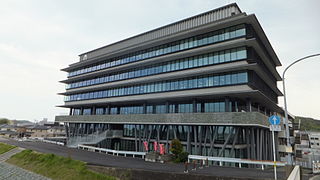
Anan is a city in Tokushima Prefecture, Japan. As of 30 June 2022, the city had an estimated population of 70,285 in 31313 households and a population density of 250 persons per km². The total area of the city is 279.25 square kilometres (107.82 sq mi).

Sanuki is a city in Kagawa Prefecture, Japan. As of 1 September 2022, the city had an estimated population of 46,016 in 20847 households and a population density of and a population density of 290 persons per km2. The total area of the city is 158.63 square kilometres (61.25 sq mi).

Miki is a town located in Kagawa Prefecture, Japan. As of 1 September 2022, the town had an estimated population of 26,449 in 10963 households and a population density of 270 persons per km2. The total area of the town is 75.78 square kilometres (29.26 sq mi).

Tadotsu is a town located in Nakatado District, Kagawa Prefecture, Japan. As of 1 October 2022, the town had an estimated population of 22,124 in 10365 households and a population density of 270 persons per km2. The total area of the town is 24.39 square kilometres (9.42 sq mi).

Itano is a town located in Itano District, Tokushima Prefecture, Japan. As of 30 June 2022, the town had an estimated population of 13,105 in 5790 households and a population density of 360 persons per km². The total area of the town is 36.22 square kilometres (13.98 sq mi).

Mima is a city located in Tokushima Prefecture, Japan. As of 1 February 2022, the city had an estimated population of 27,713 in 12,547 households and a population density of 75 persons per km2. The total area of the city is 367.14 square kilometres (141.75 sq mi).
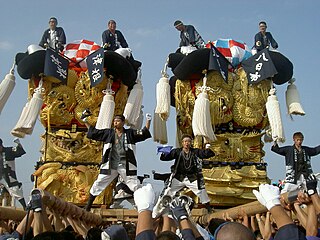
Shikokuchūō is a city located in Ehime Prefecture, Japan. As of August 31, 2022, the city had an estimated population of 83,635 in 28876 households and a population density of 200 persons per km². The total area of the city is 421.24 square kilometres (162.64 sq mi). Shikokuchūō is the leading producer of paper and paper products in Japan. It is also a port city and one of Ehime's major centers of industry.

Miyoshi is a city located in Tokushima Prefecture, Japan. As of 30 June 2022, the city had an estimated population of 23,782 in 12103 households and a population density of 33 persons per km2. The total area of the city is 721.42 square kilometres (278.54 sq mi).

Mitoyo is a city located in Kagawa Prefecture, Japan. As of 31 September 2022, the city had an estimated population of 59,876 in 23024 households and a population density of 270 persons per km2. The total area of the city is 222.73 square kilometres (86.00 sq mi).

Ayagawa is a town located in Ayauta District, Kagawa Prefecture, Japan. As of 1 October 2022, the town had an estimated population of 23,427 in 10108 households and a population density of 960 persons per km2. The total area of the town is 109.75 square kilometres (42.37 sq mi).

The Kōtoku Line is a railway line in northeastern Shikoku, Japan that connects the prefectural capitals Takamatsu (Kagawa) and Tokushima (Tokushima). Shikoku Railway Company owns and operates the line, whose name comes from the characters in the cities that the line connects: Takamatsu (高松) and Tokushima (徳島).

Takamatsu is a capital city located in Kagawa Prefecture, Japan. As of 1 November 2022, the city had an estimated population of 414,134 in 190,120 households and a population density of 1,100 persons per km2. The total area of the city is 375.41 square kilometres (144.95 sq mi). It is the capital city of the prefecture.
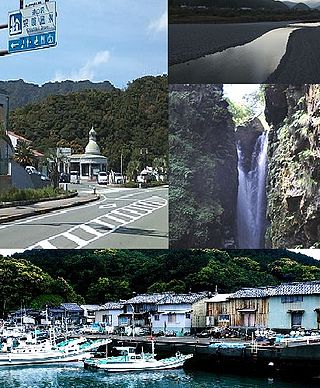
Kaiyō is a town located in Kaifu District, Tokushima Prefecture, Japan. As of 1 May 2022, the town had an estimated population of 8,699 in 4488 households and a population density of 27 persons per km². The total area of the town is 327.65 square kilometres (126.51 sq mi).
Ōkawa was a former district in Kagawa Prefecture, Japan. It included several towns in the eastern part of the prefecture.

Sanuki-Aioi Station is a passenger railway station located in the city of Higashikagawa, Kagawa Prefecture, Japan. It is operated by JR Shikoku and has the station number "T09".

Hiketa Station is a passenger railway station located in the city of Higashikagawa, Kagawa Prefecture, Japan. It is operated by JR Shikoku and has the station number "T10".
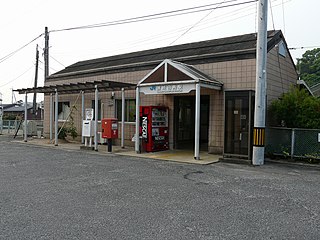
Sanuki-Shirotori Station is a passenger railway station located in the city of Higashikagawa, Kagawa Prefecture, Japan. It is operated by JR Shikoku and has the station number "T11".
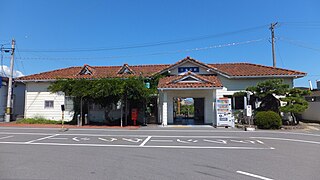
Sambommatsu Station is a passenger railway station located in the city of Higashikagawa, Kagawa Prefecture, Japan. It is operated by JR Shikoku and has the station number "T12".

Hiketa Castle was a Sengoku period Japanese castle located in what is now part of the city of Higashikagawa, Kagawa Prefecture, Japan. Its ruins have been protected by the central government as a National Historic Site since 2020.


























